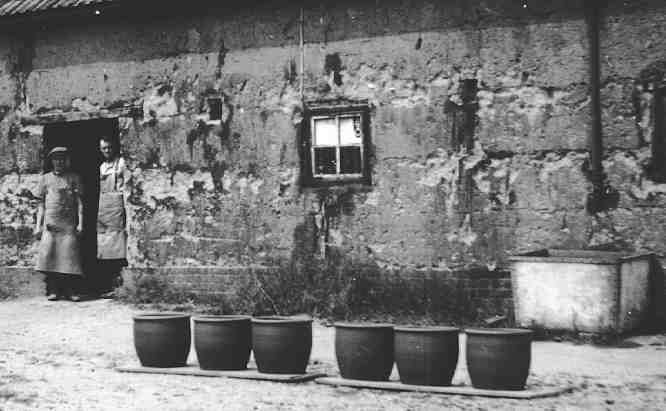
Local building - cob
|  |
Mud walls-cob cottages
Many of the cottages and virtually all the workshops and potters' drying
sheds in the Verwood area are mud walled, cob as it is called. Heywood
Sumner described the method in the early 1920's:
Mud walls should be made of sandy, clayey loam with small stones
in it; and with heath, rushes, and sedge grass, or straw, thoroughly puddled
into the mass by trampling. In the best-made mud walls this was dobbed and
bonded by the mud-waller with his trident mud-prong in successive layers on
the wall he was building. About two feet, vertical, being raised at a time
(a "rearing"), then left for ten days to dry before the next
rearing was raised on it. Walls built thus, on heathstone or brick
footings, stand well. But often they were raised without any footings, and
by inexperienced "mudders" who used the wrong sort of clay; who
did not temper it stiff with heath; and who could not build a wall with a
mud-prong, but trusted to board "clamps" and thus this serviceable
walling material has been discredited; most unfairly; mud walls that have
been well built stand firm and impervious for generations, and provide
warmth in winter and coolness in summer within the cottages which they
surround, and they cost less than walls of any other material locally
available. There is excellent mud-walling still being raised, and for such
requirements, I should go to Verwood; to Mr. Sims of Sutton Holms, Verwood,
who has inheried the knowledge of his craft, and can point out this, that,
and the other mud-walled, thatched cottage in his native village, as built
by his grandfather, his father, or himself (to the last he has recently been
adding). An outer-rough-cast coating of plaster and pebble-dash fortifies
the weatherproof nature of mud-walls, and veils a coarse material with a
serviceable finish.
From The New Forest by Heywood Sumner (1924)

Photograph: The workshop at Cross Roads pottery, Verwood in 1942. The
lines between each 'raising' of the cob are clear.

